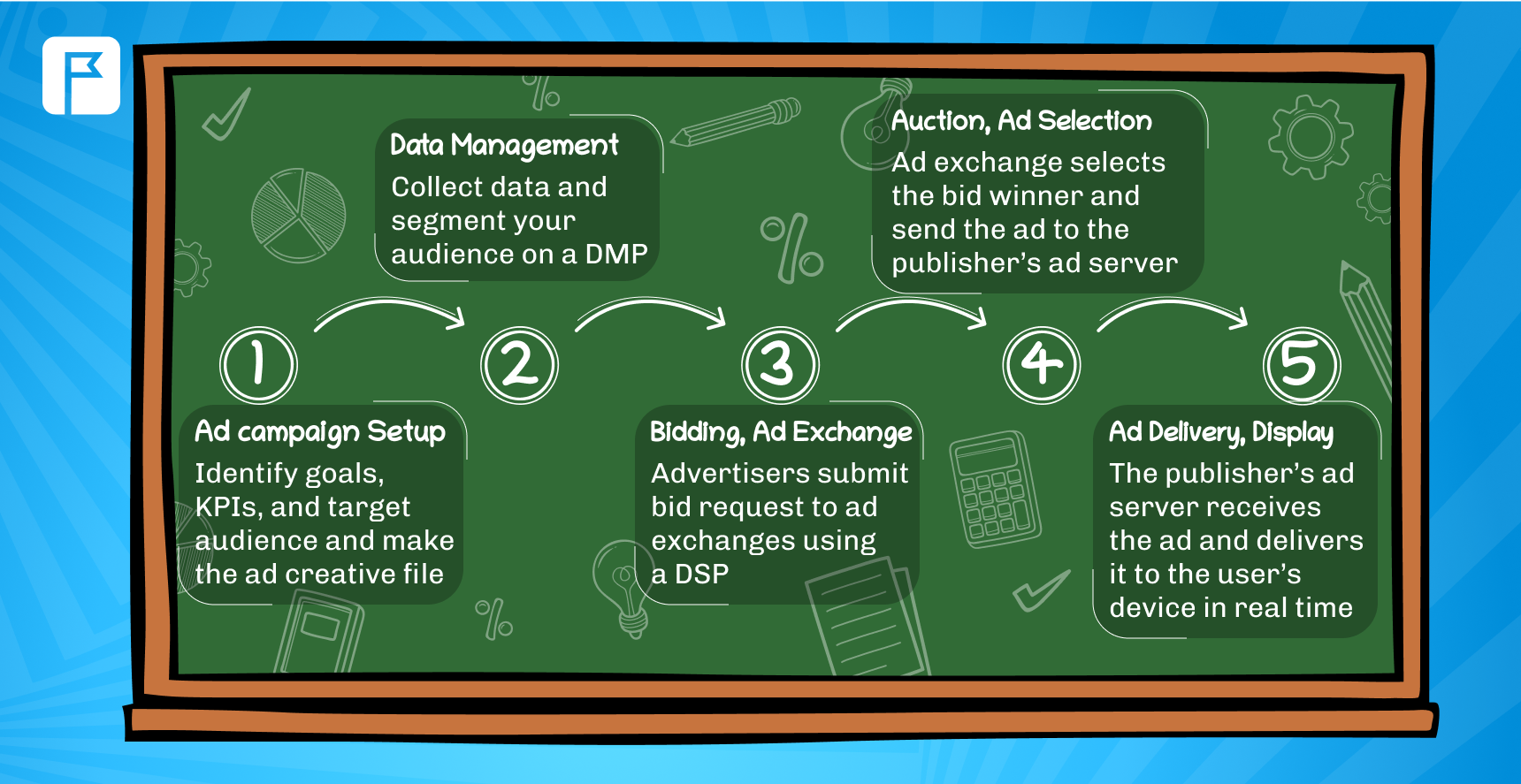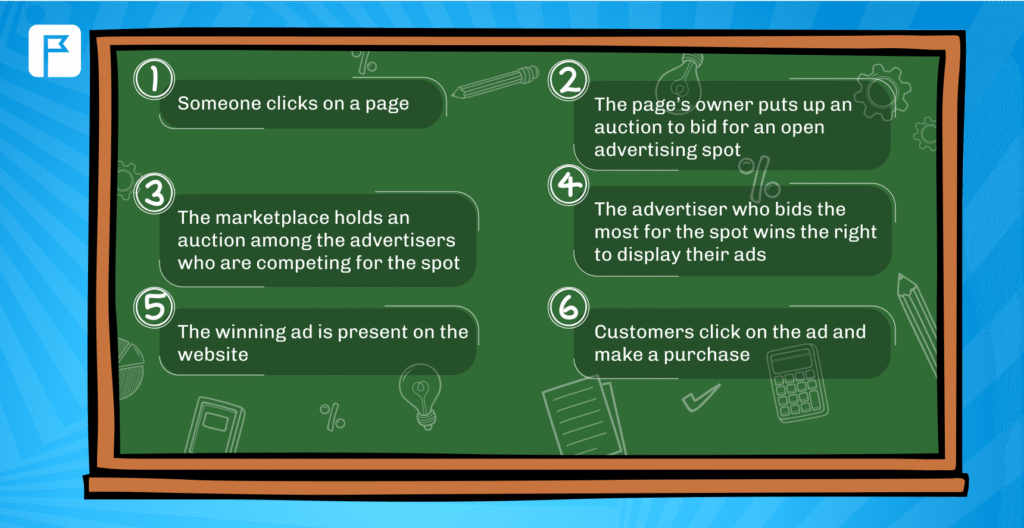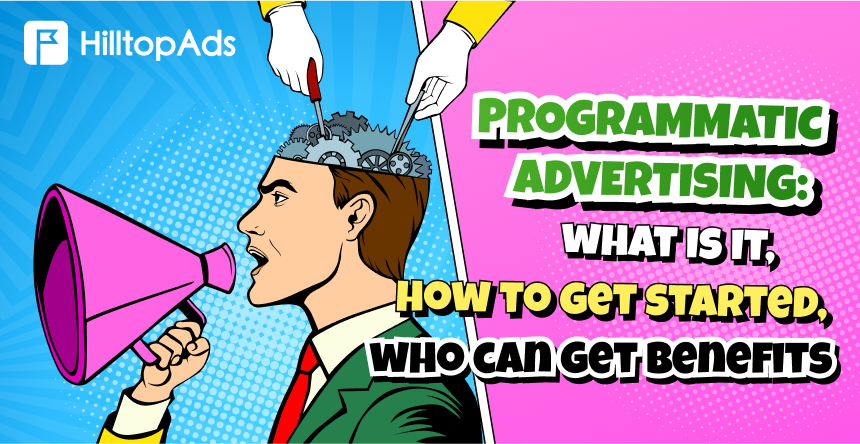Are you a bit unsure about what programmatic advertising is? You may be curious about how challenging or expensive it could be to incorporate for your business. Or maybe you are wondering if it fits well with your business goals.
This guide explains everything you need to know about programmatic advertising, which allows you to find and display ads right when they’re most relevant to your audience.
What is Programmatic Advertising: Meaning, History, Role in Digital Marketing
Programmatic advertising is using software to purchase digital ad space. Unlike some methods that required manual requests, quotes, and lengthy negotiations, programmatic systems use algorithms to automatically purchase and sell online display space.
Programmatic technology dates back to the early 2000s. 1994 is the year the first banner ad was displayed at an impressive 44% click rate, though it did not have particularly good targeting capabilities. Fast forward to 2000, when Google launched AdWords, which eventually morphed into Google’s Display Network in 2013. Around that same time, companies like Google AdEx, Microsoft AdECN, and Yahoo’s Right Media developed real-time bidding software, laying the groundwork for what we now know as modern programmatic advertising.
In digital marketing, programmatic tools take care of the nitty-gritty of ad buying, freeing up marketers to focus on creating better ads. It’s become an essential part of online advertising strategies, with global programmatic spending projected to hit a staggering $800 billion by 2028, according to Statista.

Create high-quality ads using HilltopAds!
How Does Programmatic Advertising Work?
Programmatic advertising connects two main groups: publishers with websites with ad space to sell and advertisers who want to buy that space.
Here’s the process in simple steps:
- User Clicks Link: When someone visits a website, the site sends an ad request with information about the visitor
- Ad Slot Opens: The website owner puts the ad space up for auction through a supply-side platform (SSP)
- Audience Gets Paired: The visitor data gets matched with available advertisers
- Advertisers Make Bid: Advertisers on demand-side platforms (DSPs) offer bids for the ad space
- Top Offer Wins: The highest bidder wins the ad space
- Ad Drives Traffic: The ad appears on the website for the visitor to see

This process happens in just 0.1 seconds—faster than you can blink! The programmatic system uses artificial intelligence to decide which ads to show based on what it knows about the visitor, making the ads more relevant.
Programmatic Advertising Channels in 2025
Programmatic advertising now works across many different channels, which helps advertisers reach their target audience in various ways.
Display Ads
These are the most common programmatic ads. Display ads appear in headers, footers, or sidebars of websites. They can be updated and personalized based on user data, making them more effective than static ads. Programmatic systems can place these ads on thousands of websites that match your target audience.
Video Ads
Video advertising through programmatic channels is set to reach $436 billion by 2026 and will continue to grow. There are three main types:
- In-stream ads: These show before (pre-roll), during (mid-roll), or after (post-roll) a video
- Out-stream ads: These appear within articles or as pop-ups
- In-display ads: These show up in search results or as sponsored video recommendations
Video continues to be one of the most engaging formats, with programmatic making it easier to place videos where your audience will see them.
Social Ads
Social media platforms like Ig, TikTok, Fb, and X (formerly Twitter) support programmatic advertising. These ads can be bought through APIs or through demand-side platforms that connect with these networks. Social ads help reach audience members where they spend significant time online.
Native Ads
Native ads blend into the website they appear on, creating a better user experience. Instead of standing out like banner ads, they look like natural content. Programmatic native ads can appear:
- In-feed while looking like articles on editorial pages
- In-article within paragraphs of content
- As recommendation widgets for similar content
- In search results, resembling organic listings
Audio Ads
Audio advertising has become an important programmatic channel as streaming services and podcasts continue to trend. Platforms like Spotify and Pandora offer programmatic options for reaching listeners with targeted audio messages.
In-App Ads
With people spending 4-5 hours daily on mobile apps, in-app advertising has become essential. Programmatic in-app ads include:
- Bottom-locked banners that stay in view
- Interstitials that appear between app actions
- Rewarded ads that offer benefits to users who view them
Expert Notes:
Try 2-3 different ad types at the same time to see which ones work best for you. Make sure to create ads that fit each type properly.
Pick your mix based on:
- Display ads are common and work for most businesses, but people sometimes ignore them
- Video ads get more attention but cost more to make and run
- Native ads look like normal content on the site, so people notice them more
- Audio ads work well as more people listen to podcasts and music streaming
- Digital billboards and TV streaming are good for reaching people when they’re not on computers or phones
Most businesses do best with one main type of ad that gets them sales or leads, plus some other types that help make people aware of their brand.
Programmatic Advertising Ecosystem: Buy, Sell, Other Platforms
The programmatic advertising ecosystem works like a stock exchange for ads, with different platforms handling specific roles.
Supply-Side Platform (SSP)
An SSP holds the publisher’s inventory and helps website owners sell their ad space effectively. SSPs:
- Connect publishers to multiple ad exchanges, networks, and DSPs
- Track visitor behavior through code placed on the page
- Help publishers set rates and filter ads by advertisers
- Work to maximize the value publishers get from their ad space
Publishers use SSPs to control who can buy their ad space and at what price, making sure their inventory sells for the best possible rate.
Demand-Side Platform (DSP)
Advertisers use DSPs to buy ad space across many websites at once. DSPs:
- Make automatic bids based on campaign parameters
- Use audience data to target the right people
- Connect to multiple ad exchanges and SSPs
- Provide reporting on campaign performance
DSPs help advertisers find the best places to show their ads to their target audience.
Data Management Platform (DMP)
DMPs collect and organize data from many sources to help with ad targeting. They:
- Combine first-party data (from your website), second-party data (from partners), and third-party data (from outside sources)
- Create detailed user profiles for targeting
- Help advertisers understand their audience better
- Feed targeting information to DSPs
A good DMP makes programmatic buying more effective by ensuring ads reach the right people.
Ad Exchanges
Ad exchanges are digital marketplaces where programmatic deals happen. They connect buyers and sellers, letting them complete transactions in real-time. Popular ad exchanges include:
- Google Ad Exchange (AdX)
- OpenX
- AppNexus
- Rubicon Project
These platforms facilitate the bidding process, matching advertisers with publishers.
Ad Networks
Ad networks pool unsold ad space from many publishers and sell it to advertisers at set rates. While not strictly programmatic, ad networks often connect to the programmatic ecosystem. They:
- Aggregate inventory from multiple publishers
- Offer simplified buying options for advertisers
- Often focus on specific types of inventory or audiences
Ad networks can be a simpler way to buy ads across multiple sites.
Try working with the HilltopAds ad network
to simplify your advertising strategy and start earning more!
Ad Servers
Ad servers ensure ads get delivered correctly. They:
- Store ad creative files
- Deliver the right ads to the right places
- Track impressions and clicks
- Provide reporting on ad performance
Ad servers are the technical backbone that makes sure the right ad shows up after a bid is won.
Programmatic Advertising: Pros & Cons for Digital Marketers
Programmatic advertising offers many benefits but also has some drawbacks that marketers should consider.
Pros:
Efficiency
The automated process saves time and resources compared to manual ad buying.
Targeting
Reach specific audience segments based on detailed criteria.
Real-time optimization
Adjust campaigns as they run to improve performance.
Scale
Access thousands of websites and apps through a single platform.
Data insights
Gain valuable information about your audience and campaign performance.
Cost-effective
Lower CPMs (cost per thousand impressions) compared to direct buying.
Speed
Launch campaigns quickly without lengthy negotiations.
Cons:
Ad fraud
Bots and fake traffic can waste ad spend. In 2023, about 22% of paid ad spend was lost to fraud.
Brand safety concerns
Ads might appear next to inappropriate content.
Complexity
The programmatic ecosystem can be difficult to understand.
Data privacy issues
Increasing regulations affect how audience data can be used.
Tech fees
Multiple platforms in the process each take a cut of spending.
Lack of transparency
It can be hard to know exactly where ads appear.

Programmatic advertising works best for marketers who want to reach specific audience groups efficiently. It suits both small businesses with limited budgets and large brands looking to optimize their spending.
Programmatic Advertising vs. RTB
Real-Time Bidding (RTB) and Programmatic advertising are often confused, but they’re not the same thing.
RTB is a specific type of programmatic advertising where ad space is bought and sold through real-time auctions. When someone visits a website, RTB allows advertisers to bid for that impression based on what they know about the visitor. The person with the highest bid wins, and their ad can be diplayed on the page.
The key differences are:
| Programmatic Advertising | Real-Time Bidding (RTB) |
| Umbrella term for all automated ad buying | A specific method within programmatic |
| Includes several types of deals and auctions | Only refers to open auction process |
| Can include guaranteed deals with fixed prices | Always auction-based with variable pricing |
| May involve direct relationships | Typically no direct relationship between buyer and seller |
RTB is just one way to buy ads programmatically. Other methods include private marketplaces, preferred deals, and programmatic guaranteed deals, which offer different levels of control and transparency.
While RTB offers efficiency and scale, it provides less control over where ads appear. For brands concerned about where their ads show up, other programmatic options might be better choices.

Set up and scale effective advertising companies with HilltopAds!
How to Get Started with Programmatic Advertising
Getting started with programmatic advertising doesn’t have to be complicated. Here’s a step-by-step process:
Know your marketplace
Research the programmatic landscape and learn key terms. Understanding the difference between an SSP and DSP will help you have informed conversations with vendors.
Set clear goals
Decide what you want to achieve with programmatic advertising. Are you building brand awareness? Driving app installations? Increasing online sales? Your goals will determine your approach.
Choose your platforms
Decide whether to use a self-service DSP or work with an agency that offers managed services. Self-service gives you more control but requires more expertise. Popular DSPs include:
- Google Display & Video 360
- The Trade Desk
- Amazon DSP
- MediaMath
Define your audience
Use data to create detailed audience segmentation based on demographics, interests, behaviors, and other factors.
Create a budget and bidding strategy
Determine the amount you’ll spend and how you’ll bid for inventory. Start small to test and learn before scaling up.
Create compelling ads
Design ad creative that will resonate with your target audience. Make sure to prepare different sizes and formats.
Launch and monitor
Start your campaign and closely watch its performance. Programmatic platforms provide real-time data you can use to optimize.
Optimize regularly
Use the data you collect to improve targeting, adjust bids, and refine creative to increase performance over time.
Remember that programmatic combines technology with human expertise. While the system automates buying, you still need to make strategic decisions about targeting, creative, and optimization.
Expert Notes:
New advertisers often make these mistakes:
- Buying the cheapest traffic, which usually performs poorly
- Not using tools to track what’s working
- Starting with budgets too small to learn anything useful
- Accidentally buying ad space on unsafe websites
What to do instead:
- Test different price points; sometimes paying a bit more gets much better results
- Make lists of sites that work well for you (and ones to avoid)
- Look at each traffic source separately to see what’s working
- Check if domains have security warnings using simple tools like Adsexplorer or VirusTotal
Programmatic Advertising Cost in 2025 for Advertisers and Publishers
Programmatic advertising costs vary widely based on several factors. For advertisers, understanding these costs helps with budget planning. For publishers, it affects revenue expectations.
For Advertisers:
Programmatic ads are typically priced using a CPM (cost per thousand impressions) model. In 2025, typical CPM rates range from:
- Display ads: $1-$5 CPM for standard display, $10-$25 for premium placements
- Video ads: $10-$30 CPM
- Native ads: $5-$15 CPM
- Audio ads: $8-$20 CPM
- DOOH: $10-$25 CPM
These costs are affected by:
- Your target audience (more specific = higher cost)
- Ad format and size (larger, more intrusive = higher cost)
- Device targeting (mobile often costs more than desktop)
- Geographic location (competitive markets cost more)
- Time of day or seasonality
- Industry (competitive industries like finance have higher costs)
Beyond the media cost, advertisers should budget for:
- Platform or technology fees (typically 10-20% of spend)
- Agency fees if using managed services
- Creative production costs
For Publishers:
For website owners, programmatic can be a reliable revenue source. Publishers typically receive:
- 50-70% of the advertiser’s spend (the rest goes to platforms and fees)
- Higher rates for premium inventory and audiences
- Better fill rates for their ad space compared to direct sales alone
Publishers can increase their revenue by:
- Using header bidding to increase competition for their inventory
- Creating private marketplace deals with preferred advertisers
- Offering first-party data for better targeting
- Optimizing ad layouts for higher viewability
The automated nature of programmatic helps publishers sell more of their available ad space, reducing unsold inventory.
Expert Notes:
Start with $100-$3,000 depending on what you sell. This gives you enough data to see what works.
To make your money go further:
- Set daily spending limits so you don’t use your whole budget too quickly
- Check your campaign every few days and stop spending on parts that aren’t working
- Try different ads, offers, locations, and devices to see what works best
Be careful if you see extremely high click rates (above 5%) or prices that seem too good to be true. These often mean something isn’t right with your targeting or there might be fake clicks.
Add your website and earn today!
- Advanced targeting options
- Direct traffic sources
- Self-serve platform
- Fully-managed service
- Postback tracking
- Direct traffic sources
Digital Advertising vs. Programmatic Advertising
While all programmatic advertising is digital, not all digital advertising is programmatic. Here’s how they differ:
Digital Advertising:
- Includes all online ad formats (search, social, display, video)
- Can be bought manually or automatically
- Might involve direct deals with publishers
- Often requires separate platforms for different channels
- May use broad targeting based on site content
Programmatic Advertising:
- Uses automation and algorithms for buying decisions
- Enables real-time bidding and optimization
- Allows precise audience targeting using multiple data sources
- Provides detailed analytics and reporting
- Operates across multiple channels from one platform
The main difference is that programmatic uses technology to automate and optimize the buying process, while digital advertising is simply the medium.
Programmatic offers advantages in efficiency, targeting, and scale. However, some forms of digital advertising like paid search (Google Ads) and some social media ads operate on their own platforms outside the typical programmatic ecosystem.
For most marketers, the best approach combines both: using programmatic for display, video, and audio, while managing search and some social ads through their native platforms.
Programmatic Advertising Trends in 2025
Programmatic advertising is developing quickly. These are the main trends influencing the sector in 2025:
AI and Machine Learning Advancements
Artificial intelligence makes programmatic platforms more efficient. In 2025, AI helps:
- More precise audience targeting
- Better prediction of which ads will perform best
- Spot fake clicks and views that waste your budget
- Improve your ad designs automatically
- Spread your money across different ad channels for best results
With 56% of marketers actively adopting this technology, programmatic advertising will become far more effective and faster.
Cookieless Targeting Solutions
With third-party cookies phasing out, new targeting methods have emerged:
- Contextual advertising that targets based on content rather than user data
- First-party data techniques that use customer data
- Universal IDs and alternative identifiers
- Predictive modeling to reach similar audiences
These approaches help advertisers maintain targeting accuracy while respecting user privacy.
Expert Notes:
GDPR, the end of third-party cookies, and other privacy laws have seriously transformed how we gather data. We use more transparent practices that respect user privacy while still making ads effective.
Simple changes most advertisers are making:
- Using their own customer data
- Showing ads based on website content, not personal tracking
- Looking at groups of similar users instead of individuals
- Using AI to predict interests without personal data
Connected TV Growth
Streaming services have created massive opportunities for programmatic video. With more people cutting traditional cable, CTV (Connected TV) has become a prime channel for reaching viewers through programmatic buying.
Digital Out-of-Home Expansion
Programmatic DOOH continues to grow, with more digital screens in public spaces becoming available through programmatic channels. Enhanced with features like touch screens, geofencing, and augmented reality, DOOH spending reached nearly $18 billion in 2023.
Increased Transparency
In response to advertiser demands, the programmatic ecosystem has become more transparent about fees, ad placement, and performance metrics. This helps brands understand exactly where their ads appear and what results they deliver.
Audio Opportunity
Podcasts and music streaming platforms have created new inventory for programmatic audio. This channel continues to grow as listeners shift from traditional radio to digital audio platforms.
Increased Focus on Privacy
Stronger privacy regulations have pushed the industry toward more ethical data practices. Programmatic platforms now emphasize consent-based data collection and privacy-friendly targeting methods.
Final Thoughts about Programmatic Advertising
Programmatic advertising gives access to better targeting practices and expands opportunities across channels like Connected TV and digital out-of-home.
Programmatic advertising offers various key benefits for advertisers, such as precise audience targeting, real-time optimization, and ranking across multiple channels. Businesses of all sizes—from small companies with limited budgets to global brands looking to refine their digital strategies—can certainly benefit from programmatic advertising.
So, who should work with programmatic advertising? Essentially, any business that wants to reach specific groups efficiently across the web. If you value data-driven marketing, optimized spending, and the ability to adjust campaigns in real-time, programmatic advertising offers advantages that traditional buying methods simply can’t match.



















